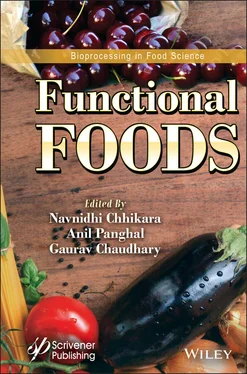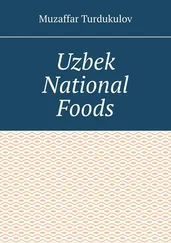Functional Foods
Здесь есть возможность читать онлайн «Functional Foods» — ознакомительный отрывок электронной книги совершенно бесплатно, а после прочтения отрывка купить полную версию. В некоторых случаях можно слушать аудио, скачать через торрент в формате fb2 и присутствует краткое содержание. Жанр: unrecognised, на английском языке. Описание произведения, (предисловие) а так же отзывы посетителей доступны на портале библиотеки ЛибКат.
- Название:Functional Foods
- Автор:
- Жанр:
- Год:неизвестен
- ISBN:нет данных
- Рейтинг книги:3 / 5. Голосов: 1
-
Избранное:Добавить в избранное
- Отзывы:
-
Ваша оценка:
- 60
- 1
- 2
- 3
- 4
- 5
Functional Foods: краткое содержание, описание и аннотация
Предлагаем к чтению аннотацию, описание, краткое содержание или предисловие (зависит от того, что написал сам автор книги «Functional Foods»). Если вы не нашли необходимую информацию о книге — напишите в комментариях, мы постараемся отыскать её.
Presenting cutting-edge information on new and emerging food engineering processes,
, the second volume in the groundbreaking new series, “Bioprocessing in Food Science,” is an essential reference on the modeling, quality, safety, and technologies associated with food processing operations today.
This outstanding new volume:
Audience: Functional Foods
Functional Foods — читать онлайн ознакомительный отрывок
Ниже представлен текст книги, разбитый по страницам. Система сохранения места последней прочитанной страницы, позволяет с удобством читать онлайн бесплатно книгу «Functional Foods», без необходимости каждый раз заново искать на чём Вы остановились. Поставьте закладку, и сможете в любой момент перейти на страницу, на которой закончили чтение.
Интервал:
Закладка:
In the daily diet, the consumption of oats, which contain β-glucan polysaccharides, various dietary fiber components, and antioxidant compounds like tocopherol, wields a positive influence on consumer health and decreases the risks of various illnesses and malignancies [104]. In many studies, the valuable fiber components in oats were found to exert both therapeutic and protective activities against cardiovascular diseases, type-2 diabetes mellitus, and various types of cancer, like colon cancer [105–109]. The β-glucans found in oats are reported to have an association with oat’s ability to lower blood cholesterol levels [109]. New data also show that oats positively affect body weight and blood pressure [79].
3.2.4 Barley
Barley is known as one of the most ancient cereals to have been produced throughout the world. Archaeological proof demonstrates barley’s presence along Egypt’s Nile River about 17,000 years ago [110, 111]. Production of barley, scientifically known as Hordeum vulgare L., ranks 4th globally after respective maize, rice, and wheat production [112, 113]. Approximately 12% of the grain cultivated in the world is barley [111, 114]. Barley is utilized as one of the necessary raw materials for producing malt and beer, also being widely consumed in the production processes for animal feed [113, 115]. It has been generally used in the feeding of poultry, pigs, and adult ruminants and monogastrics [116, 117]. Of the barley being grown today, approximately 65% is utilized for animal feed, while 33% is used for malt products and 2% is reserved for human consumption [111, 118]. Barley can be farmed on diverse types of soil and in various climates, and it is used by many different cultures and nations [119, 120]. Compared to other types of cereals, it performs better under varied environmental pressures because it is drought-resistant, survives well in winter, and matures early; therefore, it is commonly more economically cultivated compared to other possible crops [111, 121]. The United States, China, India, Russia, and other countries from the former USSR are the major barley-producing countries [122].
Barley grains primarily comprise the husk, the embryo, and the endosperm, consisting of the aleurone and of endosperm cells, which are starchy [123]. The husk is the outer layer of the barley and forms 10%–13% of the grain weight [123, 124]. The embryo is made up of an acrospire, which is a nodal region located in between the shoot and root, as well as a primary root, which is enclosed by a root sheath known as the coleorhiza. Embryos are disconnected from the endosperm during germination by the modified cotyledon (the scutellum) [123, 125]. The endosperm comprises a starchy part and a layer of aleurone around it. The endosperm constitutes the major unit of a barley grain, representing 75% of a grain’s weight [123, 124]. The endosperm’s task is to function like a starchy storage center for nutrients that embryos can utilize in the process of germination [99, 123]. The cells in the aleurone layer include lipids, protein, minerals, and vitamins [123, 124, 126, 127]. Aleurone cells are isodiametric, which is different from the endosperm cells. Apart from the embryo, the sole unit of the grain that contains living cells is the aleurone layer [123, 125].
Barley genotypes are classified as hulled and hull-less. The hull-less variety has better nutritional value compared to the hulled one [120, 128]. Hull-less barley generally has higher amino acid, total protein, and digestible energy contents compared to hulled barley [129–131]. Barley can be described as a perfect source for obtaining β-glucans and complex carbohydrates, two critical constituents of dietary fiber [132]. Barley grain contains 60%–80% carbohydrates, 9%–13% protein contents, 1%–2% fat, and 10%–15% water [132, 133]. The most limiting essential amino acid of cereal species, namely lysine, is found in higher levels in some cultivars [129–131]. Starch is the carbohydrate to be found most plentifully in barley grain, its levels varying between 62% and 77% in terms of the dry grain weight [132, 134]. The dietary fiber content of barley is 14%–25%. Arabinoxylan content is 4%–11%, while the β-glucans, cellulose, and lignin contents are 3%–7% [135–138]. Barley is rich in vitamins, particularly B vitamins, and it also has valuable mineral contents, especially trace minerals [139, 140]. Apart from β-glucans, the compounds in barley such as tocotrienol, phytoestrogens, lignans, polyphenols and phytic acid have been associated with health benefits [140, 141].
Epidemiological studies show that regular barley consumption has the possible ability of lowering the risks of various chronic diseases including colon cancer [111, 142, 143], chronic heart disease [111, 118, 144, 145], gallstones [111, 146, 147], and high blood pressure [111, 148]. There are reports of the role of barley in the maintenance of colon health [111, 149], the induction of stimulation of the immune system [111, 150], and immuno-enhancement [111]. In addition, barley consumption provides a protective effect against toxins, diabetes mellitus, and neurological problems such as Alzheimer disease [111, 151, 152].
3.2.5 Flaxseed
Flaxseed comes from Linum usitatissimum L., which is commonly called the flax plant and belongs to the family Linaceae [153–155]. It is also called linseed [156, 157], and it is native to Western Asia and Mediterranean areas [153–155]. Today, however, it is grown in over 50 countries, mainly in areas of the northern hemisphere. Canada produces and exports the largest quantity of flaxseed in the world [153, 158], and India, the United States, China, and Ethiopia are the other major countries that grow flax plant for its seeds [158–161]. In the world, India ranks first in terms of flaxseed cultivation area and third in terms of flaxseed production [158, 160, 161]. The first known evidence of flax cultivation is the use of the flax plant in the manufacture of linen fabric in eastern Turkey in 6000 BC [162, 163]. Flaxseed is used from past to present to obtain linseed oil for industrial purposes such as linoleum, paint, varnish, cosmetics, and ink production [157, 164, 165]. While flax fiber is valuable in producing high-quality linen clothing, milled or ground flaxseed is commonly used as a component of fertilizers and in foodstuffs for animals [162, 163]. Flaxseed is also of value in functional foods because it has several beneficial pharmaceutical and nutritional properties [157, 166].
The seeds of flax plants are oval-shaped and flat; their tips are pointed. They range in color from dark shades to yellow [160, 162]. Seeds are about 3.0–6.4 mm long, 1.8–3.4 mm wide, and 0.5–1.6 mm thick [155, 162]. Embryos account for 55% of hand-cut flaxseed’s overall weight, while the seed coat and endosperm represent 36% of overall weight. Finally, the embryo axis accounts for 4% [160, 162]. Oily flaxseeds are generally larger than fibrous flaxseeds [155, 167]. Flaxseeds possess a chewy, crisp texture and they have a pleasing nutty flavor [155, 168].
The chemical composition of flaxseed depends upon the environmental conditions in which the flax is grown and differs significantly among varieties [169]. The Canadian Grain Commission reported that one variety of Canadian flaxseed had a composition including 41% fat, 20% protein, 28% total dietary fiber, 7.7% moisture, and 3.4% ash [170]. Minor components in flaxseed are vitamins (A, B, D, E) and minerals (cadmium, selenium, etc.), cyanogenic glycosides, trypsin inhibitor, phytic acid, lignans, lina-tine, polyphenols, and cyclolinopeptides (CLs) [162, 170, 171]. Flaxseed includes 8–10 g/kg total polyphenols, about 5 g/kg esterified polyphenols, and 3–5 g/kg etherified polyphenols [172]. It constitutes the richest available resource for obtaining n-3 fatty acid, also known as alpha-linolenic acid. This particular acid accounts for roughly 55% of the total fatty acids that are present in the seeds of this plant [157, 163]. Alpha-linolenic acid may be metabolized by certain types of enzymes in the human intestine to docosahexaenoic acid and eicosapentaenoic acid [157, 173]. It was established that increasing the intake of long-chain polyunsaturated fatty acids in one’s diet, and particularly one’s intake of docosahexaenoic and eicosapentaenoic acids, can reduce disease risks [157, 174].
Читать дальшеИнтервал:
Закладка:
Похожие книги на «Functional Foods»
Представляем Вашему вниманию похожие книги на «Functional Foods» списком для выбора. Мы отобрали схожую по названию и смыслу литературу в надежде предоставить читателям больше вариантов отыскать новые, интересные, ещё непрочитанные произведения.
Обсуждение, отзывы о книге «Functional Foods» и просто собственные мнения читателей. Оставьте ваши комментарии, напишите, что Вы думаете о произведении, его смысле или главных героях. Укажите что конкретно понравилось, а что нет, и почему Вы так считаете.










